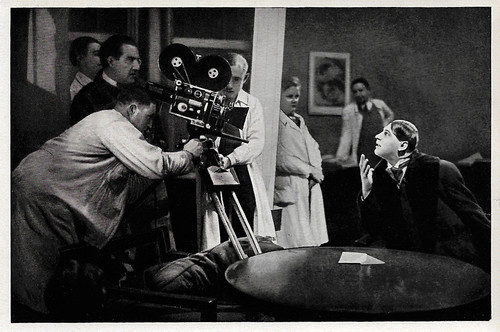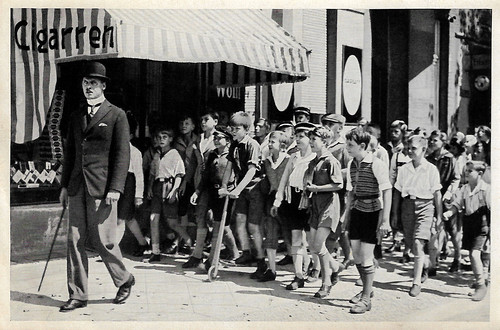
German postcard by Ross Verlag, no. 1738/1, 1927-1928. Photo: Ufa.

German postcard by Ross Verlag, no. 6828/1, 1931-1932. Photo: Ufa.
Typecast as the Villain
Fritz Heinrich Rasp was born in Bayreuth, Germany in 1891. He was the thirteenth child of the county surveyor Daniel Rasp and his wife Auguste Rasp-Grähl. Fritz studied acting at the Theaterschule Otto Königin in München (Munich). Rasp debuted on the stage in 1909, as Amandus in Max Halbe's scandalous play 'Jugend' (Youth) as the Münchner Schauspielhaus, and in 1914 he went on to work with the famous Max Reinhardt at the Deutschen Theater in Berlin.
In 1916 he made his film debut in the silent comedy Schuhpalast Pinkus/Shoe Palace Pinkus (Ernst Lubitsch, 1916) starring Lubitsch himself and Ossi Oswalda. It was part of the Sally series of films featuring Lubitsch as Sally, a sharp young Berliner of Jewish heritage. After leaving school, the self-confident young man goes to work in a shoe shop and soon becomes a shoe tycoon.
Rasp also appeared in the fairy-tale Hans Trutz im Schlaraffenland/Hans Trutz in the land of plenty (Paul Wegener, 1917). After his military service (1916-1918), he started to work for Max Reinhardt again. His breakthrough as a screen actor came in 1922 when he played one of the main characters in Fred Sauer’s film adaptation of the play Jugend/Youth.
During the early 1920s he appeared in such silent films as Zwischen Abend und Morgen/Between Evening and Morning (Arthur Robison, 1923) starring Werner Krauss, the expressionist film Schatten – Eine nächtliche Halluzination/Warning Shadows (Arthur Robison, 1923) with Alexander Granach, and Ein Sommernachtstraum/Wood Love (Hans Neumann, 1925), an adaptation of William Shakespeare's 'A Midsummer Night's Dream' starring Werner Krauss, Valeska Gert and Alexander Granach. Filmportal.de: “While he was extremely versatile on stage, the screen actor Fritz Rasp – lean and tall with a narrow mouth and sunken eyes – is quickly typecast as the villain, a role which he often managed to subvert by adding layers of irony and psychological depth to his characters.”
A beautiful example is his part as Fredersen's spy Der Schmale (The Thin Man) in Fritz Lang's expressionist epic Metropolis (1927). The classic science-fiction film was written by Lang and his wife Thea von Harbou, and starred Brigitte Helm, Gustav Fröhlich, Alfred Abel (Joh Fredersen, the master of Metropolis) and Rudolf Klein-Rogge. Many of the scenes in which Rasp appears were part of the Metropolis footage long believed lost until their recovery in 2008. His role in Metropolis was soon followed by supporting parts in other masterpieces of the Weimar cinema, such as Die Liebe der Jeanne Ney/The Love of Jeanne Ney (Georg Wilhelm Pabst, 1927), and Spione/Spies (Fritz Lang, 1928).

German collectors card by Ross Verlag in the series Vom Werden Deutscher Filmkunst - Der Stumme Film, no. 169, Group 43. Photo: Ufa. Fritz Lang and Fritz Rasp at the set of Frau im Mond/Woman in the Moon (Fritz Lang, 1929).

German collectors card in the series 'Vom Werden deutscher Filmkunst - Der Tonfilm', album no. 11, picture no. 58, group 44. Photo: Ufa / Ross Verlag. Fritz Rasp in Emil und die Detektive/Emil and the Detectives (Gerhard Lamprecht, 1931).
Sherlock Holmes and Father Brown
Fritz Rasp also appeared in very popular entertainment films like Der letzte Walzer/The Last Waltz. The film was one of five multi-language versions of the American film Dangerous Paradise (1930) made by Paramount at the Joinville Studios in Paris. These were made in the years following the introduction of the sound film before the practice of dubbing became widespread.
During the Nazi era, he only got small roles in films like the comedy Onkel Bräsig/Uncle Bräsig (Erich Waschneck, 1936) and the mystery Der Hund von Baskerville/The Hound of the Baskervilles (Karel Lamač aka Carl Lamac, 1937), an adaptation of the Sherlock Holmes's story 'The Hound of the Baskervilles' by Arthur Conan Doyle. In 1943, he reunited with director Georg Wilhelm Pabst for the drama Paracelsus (G.W. Pabst, 1943) based on the life of Paracelsus (Werner Krauss).
After the war, he first appeared in Eastern Germany in productions by the DEFA. He also performed on the stages of Berlin. Later he was seen in West-German light entertainment films like the mystery Das schwarze Schaf /The Black Sheep (Helmut Ashley, 1960) starring Heinz Rühmann and based on the Father Brown stories by G.K. Chesterton.
Rasp also played in the popular Edgar Wallace adaptations of the 1960s, such as Der rote Kreis/The Crimson Circle (Jürgen Roland, 1960), Die seltsame Gräfin/The Strange Countess (Josef von Báky, 1961) and Das Rätsel der roten Orchidee/The Puzzle of the Red Orchid (Helmut Ashley, 1962) starring Christopher Lee.
In 1963 he was honoured for his work in the German cinema with the Filmband in Gold award. One of his last films was the sweet crime comedy Lina Braake (Bernhard Sinkel, 1975), in which Lina Carstens and he played revolting seniors who rob a bank. Fritz Rasp died in 1976 in Gräfelfing, Germany. He was 85. His wife was Charlotte Petermann.

German postcard. Photo: Cicero Film / Distribution Deutsche Tonfilme. The 'fine fleur' of late silent German cinema stars, united for a photo for an early sound film company. Standing left to right: Francis/Franz Lederer, Walter Rilla, Theodor Loos, Camilla Horn, Fritz Rasp and Walter Janssen, Sitting left to right: Paul Heidemann, Charlotte Susa, Betty Amann, Olga Tschechowa, Maria Paudler and Jack Trevor. Might be publicity for the early sound comedy Die grosse Sehnsucht/The Great Longing (Stefan Szekely/Steve Sekely, 1930), in which all acted, mostly as themselves - only Loos and Horn played characters. The plot was an excuse for 35 stars to debut in a talking picture.

German collectors card. With Hilde von Stolz.
Sources: Filmportal.de, Wikipedia (German and English) and IMDb.
This post was last updated on 17 May 2022.
No comments:
Post a Comment